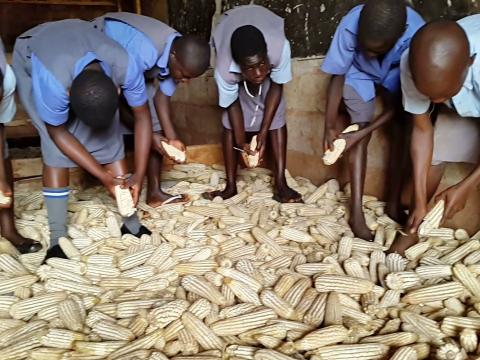School feeding programme improves enrolment and retention in Buikwe

Flavia Lanyero
Buikwe
Namulesa SDA Primary School is one of the largest schools in Ngogwe Sub-county, Buikwe district but has not had many pupils to match the classrooms. In 2010 the school had an enrolment of only 28 pupils many of whom later dropped out.
The school head master Charles Okuta says that he was puzzled about how to increase school enrollment and retention given the fact that he knew children were around loitering and working in people’s gardens. Indeed as one drives through Ngogwe, it is not uncommon to find children during class hours out on the road or in the fields despite the fact that there are many schools offering free education through government’s Universal Primary Education programme.
Through consultation with the pupils, leaders and Ngogwe community, it immerged that very few children took a meal before they came to school. This meant that pupils left home hungry; they stayed at school hungry, since the school did not provide meals, and only ate in the evening when they went back home. Many families cannot afford to pack for children lunch which is a requirement for the UPE schools. Ngogwe ADP baseline data shows that only 43 percent of households can afford a meal a day.
For this reason, World Vision in 2010 introduced a Community School feeding programme in which schools take lead in producing food for children to eat while at school. Each class grows a different type of food and later the whole school feeds on the different types of food.
“In primary six we grow maize and in primary five we grow maize as well. This maize is used to cook porridge for break time as well as for food during lunch,” narrates Rachael Narwada, a primary six pupil. “Before the school feeding programme came, we never used to have lunch at school and sometime we could stay hungry the whole day,” she says.
In this programme, the school produces different types of food including beans, maize and sweet potatoes. The school also provides local resources like land while the pupils provide the labour during co-curricular activities at 4 pm.
“This innovation is a game charger to assist teachers, care-givers and children to make daily food choices that combine good health, pleasure and responsibility. The role of the cluster is to provide good quality and fast maturing seeds as well s capacity building to grow the food,” says Mr Obed Byamugisha, a Child Protections and Development Facilitator based in Ngogwe adding: “When a child eats a meal at school it means they will not escape to look for food and they will not drop out of school.”
The programme has yielded results. Mr Okuta says that currently both pupils and teachers to concentrate at school which has seen the school improve in performance, enrolment and retention of pupils. The school now boosts of 314 pupils up from the 28 they had in 2010.
“Teachers now get breakfast and lunch at school which has helped them concentrate on teaching because they are sure that they will get lunch at school also the pupils are always at school to be taught,” says Mr Okuta.
World Vision has scaled up the programme to 10 other schools in Nogwe Sub-county. Namulesa Primary School, however, still has challenges. The school buildings are dilapidated with ruined floor and corrugated iron sheets. The doors are broken and the windows do not have louvers so when it rains, the rain easily showers on the children. Also some classrooms have been turned into dormitories in a desperate move to have a boarding section that can increase pupil’s concentration.